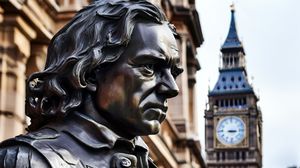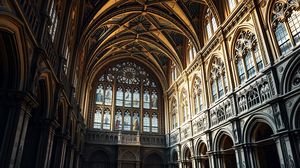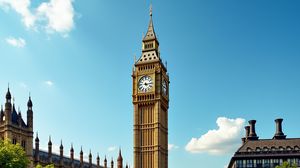
The Oliver Cromwell Statue in Westminster is a compelling monument located outside the Houses of Parliament in London. This statue commemorates Oliver Cromwell, a contentious figure in British history, who served as the Lord Protector of the Commonwealth of England, Scotland, and Ireland in the mid-17th century. The statue stands near the historic heart of British governance, making it a point of interest for those intrigued by England's political past.
Unveiled in 1899, the bronze statue of Oliver Cromwell was sculpted by Hamo Thornycroft, a noted British sculptor recognized for his works that capture the essence of historical figures. This statue itself portrays Cromwell in military attire, complete with a sword and a bible, symbolizing his leadership and Puritan beliefs, presenting a vivid depiction of his dual role as both a soldier and a reformer.
The statue's installation was surrounded by controversy because of Cromwell's divisive legacy. Known for his role in the English Civil War, and for being the figurehead of the Parliamentary cause against the King, Cromwell's rule remains contentious. The Irish population in particular views him unfavorably due to his military campaigns in Ireland, which were marked by brutality.
A curious element about the statue is its financial backing. Unlike many public statues of historical figures, this one was funded entirely by a private donation from Lord Rosebery, a former British Prime Minister, who admired Cromwell's role in shaping modern Britain.
An interesting detail is that this statue stands outside a building packed with historical significance itself — the Houses of Parliament are home to the UK's legislature. Scenes of political decision and development seen by Cromwell in his lifetime remain core to the British political system today.
The Oliver Cromwell Statue does not shy away from historical complexity; instead, it provides visitors with an opportunity to reflect on the often challenging and multifaceted nature of power, revolution, and governance.

Making the Most of Your Visit:
Look closely at the detail: The craftsmanship of Hamo Thornycroft's bronze work is impressive. Pay attention to the intricate details like Cromwell's military attire, which includes subtle textures and nuances that reflect his dual role as both soldier and reformer. These details provide a deeper understanding of the artist's intention to portray the complexity of Cromwell's character.
Visit during Parliament's recess: If you visit when Parliament is not in session, you'll find the area to be less crowded. This gives you a better opportunity to carefully view and photograph the statue without the hustle and bustle of busy crowds, providing a more peaceful experience.
Reflect on the symbolism: Notice that Cromwell is holding both a sword and a bible. This dual imagery encourages a moment of reflection on his dichotomous role in history. Consider what these symbols might mean regarding his impact on English governance and religious revolution.
Check out the historical plaques: Look around the base of the statue for informative plaques that offer additional historical context. Learning about the statue's background, funding by Lord Rosebery, and Cromwell's divisive legacy will enhance your understanding of why this monument was so controversial.
Blend it with a walk: Combine your visit with a stroll along Parliament Square. This will provide you with a glimpse of other significant statues and a panoramic view of the iconic structures of Westminster, embedding the Cromwell statue within a wider historical narrative.

Visiting Times & Costs:
The Oliver Cromwell Statue in Westminster is accessible to the public at all times, as it is located outdoors in Parliament Square, near the Houses of Parliament. There are no restricted visiting hours, making it possible to view the statue year-round, regardless of the time of day.
There is no entry fee required to see the Oliver Cromwell Statue. It is freely accessible to anyone wishing to visit.
In terms of accessibility, the statue is situated in a public area that is generally accessible to individuals with mobility impairments. The pathways around Parliament Square are designed to accommodate wheelchair access, but visitors should be aware that some areas can be busy, potentially affecting the ease of movement.

Address & Map:

Nearby:























